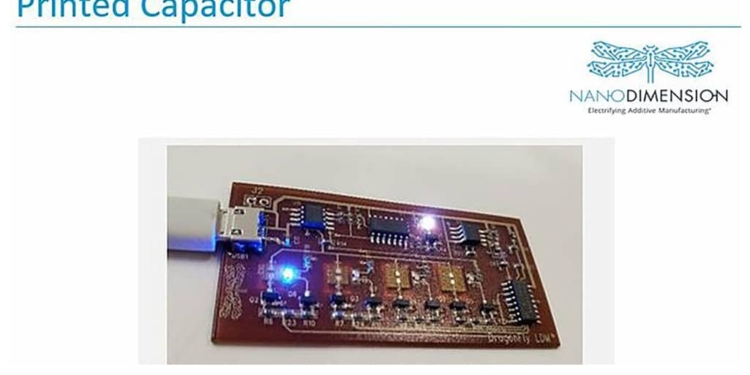Source: Nano-Dimension news
NESS ZIONA, Israel, – Nano Dimension Ltd., a leading additive electronics provider for electronics, announced that it has developed 3D printed capacitors with the Company’s pioneering DragonFly additive manufacturing system. These capacitors are embedded in the body of the additively manufactured printed circuit boards (PCBs), saving space and eliminating the need for assembly. This breakthrough in the additive manufacturing of electronics validates the manufacturing applicability of built in capacitors in PCBs printed with the award-winning DragonFly system, the only precision additive manufacturing system of its type.
Nano Dimension’s extensive testing with capacitors of different 3D dimensions have shown consistent results with statistically validated data. The repeatability results show less than 1% variance. The technology uses the same dielectric and metal traces as in the additively manufactured PCB yielding capacitors with a capacitance range from 0.1nF to 3.2nF. The successful results are based on over 260 tests with 30 different additively manufactured capacitors dimensions.
By integrating capacitors using additive manufacturing, electronics designers and manufacturers can avoid what is often a time consuming, multi-step assembly process, as the DragonFly prints the entire capacitor and PCB in one print job. This allows companies to reduce the fabrication time and overcome many of the challenges imposed by traditional production techniques.
Additively manufacturing capacitors within the inner layers of circuits also can free space to meet the ever-increasing trend towards miniaturization and flatness of electronic devices for consumer, industrial and military applications. With extra space, designers may pack more functionality on the circuit board and shrink component size – all without compromising reliability.
Capacitors of this kind are primarily used to filter electrical noise and ripple voltage for a wide range of applications, including RF transmission lines, audio processing, radio reception and power circuit conditioning.
“The test results clearly show that with the DragonFly system our customers can achieve repeatability comparable to that of traditional processes in short run manufacturing of capacitors using 3D printing,” said Amit Dror, CEO of Nano Dimension. “Along with high accuracy, miniaturization and space saving on the board, these are key factors in the electronics production process and next generation electronics applications.”
About Nano Dimension
Nano Dimension (Nasdaq, TASE: NNDM) is a leading electronics provider that is disrupting, reshaping, and defining the future of how cognitive connected products are made. With its unique 3D printing technologies, Nano Dimension is targeting the growing demand for electronic devices that require increasingly sophisticated features. Demand for circuitry, including PCBs – which are the heart of every electronic device – covers a diverse range of industries, including consumer electronics, medical devices, defense, aerospace, automotive, IoT and telecom. These sectors can all benefit greatly from Nano Dimension’s products and services for rapid prototyping and short-run manufacturing. For more information, please visit www.nano-di.com.































